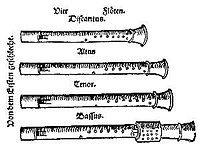
Photo from wikipedia
The key parameters musicians consider when they evaluate the quality of a musical instrument are its tuning (reproducing a musical scale), sound quality, and ergonomics. Musical instrument makers, even up… Click to show full abstract
The key parameters musicians consider when they evaluate the quality of a musical instrument are its tuning (reproducing a musical scale), sound quality, and ergonomics. Musical instrument makers, even up to this day, primarily base their practice on empirical knowledge and costly physical experimentation. A computational model that combines all the aforementioned key parameters is presented to predict the building details of an instrument. The simulation of the instrument is introduced to a multi-objective optimizer to calculate its optimal set of geometrical and material features, considering the importance of the three key parameters. For a string musical instrument this approach is based on a hybrid model of Digital Signal Processing simulating the vibrating string and of Finite Elements Method simulating the effect of the body. The simulation technique has been validated by building an ancient guitar and comparing its recordings with its analogous digital model. The proposed method can be put into practice to investigate the building details of any instrument by introducing the relevant simulation and the objective’s function parameters. This work is expected to provide a powerful tool for the musical instrument makers towards a more efficient design of a bespoke instrument.
Journal Title: IEEE Access
Year Published: 2022
Link to full text (if available)
Share on Social Media: Sign Up to like & get
recommendations!